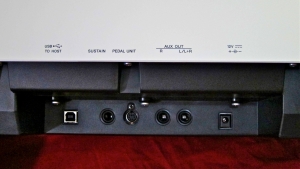****
The brand-new Yamaha P-105 is an affordable, lightweight digital piano, ideal for home use and stress-free gigging.
Yamaha’s P-105 (current street price in Finland around 660 €) is offered in black (P-105B), as well as in a pearl white finish (P-105WH).
The P-105 is equipped with a Yamaha Graded Hammer keyboard, which offers a feel similar to an acoustic piano: The bass keys put up slightly more resistance than the treble keys.
Thanks to its plastic chassis the Yamaha weighs in at a mere 12 kilos, and it fits easily on your standard X-type keyboard stand. For home use you can also purchase the wooden LH85-stand and the three-pedal LP5A -pedal unit.
In addition to its quality keyboard the Yamaha P-105 also trumps with a full-bodied two-way speaker system offering 14 Watts of power (2 x 7 W).
The Yamaha P-105 is feature-packed, yet easy to use.
Next to the Volume-fader you’ll find the buttons for the built-in metronome, as well as Yamaha’s Pianist-function and the keyboard split.
In addition to a traditional metronome click, the P-105 also offers ten different drum patterns from Beat to Samba and Waltz.
The Pianist-function is a practicing tool – akin to a cross between an arpeggiator and auto-accompaniment – which changes held left-hand chords into different accompaniment styles. This allows you to focus your practicing first on the right hand only, while simply holding down the correct chords with your left hand. The Pianist-function offers ten different accompaniment styles from classical to Pop and Latin.
The Tempo-buttons on the P-105 also function as keyboard split selectors for assigning different sounds to the left and right half of the keyboard, respectively.
Layering two sounds is also extremely easy on the Yamaha: You select the first sound just as you would when switching to a different sound. Then, while holding down the first sound’s selection button, you choose the second sound you want to layer on top of the first one.
The Yamaha P-105 is also equipped with a very basic recording and playback section.
The sounds available from the Yamaha P-105 cover all the usual bases. There are 14 tones on offer, starting with acoustic and electric pianos, and ending with strings and bass-sounds.
Apart from the two headphone outputs on the front panel, all of the connectors can be found on the P-105’s recessed back panel.
In addition to a simple sustain pedal jack there’s also the special connector for Yamaha’s three-pedal LP5A-unit. This digital piano also offers a line level stereo output, as well as a USB-port for use as a master keyboard in conjunction with your sequencer software.
The P-105’s PSU (and especially its thin lead) isn’t the most gig-worthy I’ve ever seen. The included sustain pedal is a very nice touch, mind.
****
In my opinion two points are essential, when it comes to the quality of a digital piano – you look for an authentic piano touch, as well as quality sounds (especially with regard to the grand piano tones). All other features are like the icing on a cake – nice to have, but they won’t make or break the instrument.
When it comes to its keyboard Yamaha’s P-105 is a sure-fire winner: Yes, it is true, the feel and touch of its keyboard (naturally) isn’t on a par with Yamaha’s most expensive digital pianos, but I feel that the P-105’s touch and response is one of the best (if not the best) in its price range. The keys feel and respond quite naturally, and the mechanical noise the keyboard makes in use is refreshingly quiet and unobtrusive.
The most exciting news, though, are the P-105’s superb grand piano sounds, which put this affordable digital piano in a class of its own. Grand Piano 1 offers the tone of a very well recorded Yamaha CFIIIS -grand. The natural nuances and the wide dynamic range on offer are a testament to Yamaha’s expertise in this field.
Grand Piano 2 is a slightly more aggressive and brighter affair, made to cut through Pop and Rock arrangements.
I had the feeling that I could make out a very slight fluctuation in pitch during the attack phase, when hitting the ”g” and ”a” below the ”middle C” very hard. But it also may have been some strange sort of psycho-acoustic gremlin in my head.
There’s still more quality on offer in the Yamaha P-105’s electric piano section, which offers four different tones from vintage all the way to DX7-type sounds.
The Yamaha’s other sounds are also in great form. I especially liked the pipe organ, the harpsichord and the strings.
Here are two examples of the Pianist-function and the drum patterns on offers. As with all the other soundbites, these too have been recorded straight from the line output to my sequencer with all the EQ and reverb coming solely from the P-105.
In my opinion, the Yamaha P-105 is a fantastic choice if you’re shopping for a lightweight and affordable digital piano, as it offers both a natural-feeling keyboard and quality tones. This digital piano is ideal for the hobby pianist, as well as for the gigging keyboarder, who has to transport his (or her) own equipment.
****
Yamaha P-105WH
Current price in Finland approximately 660 €
Finnish distributor: F-Musiikki
****
Pros:
+ Graded Hammer -keyboard
+ grand piano sounds
+ variety of sounds
+ good speaker system
+ lightweight
+ value-for-money
Cons:
– PSU probably not gig-worthy
****










